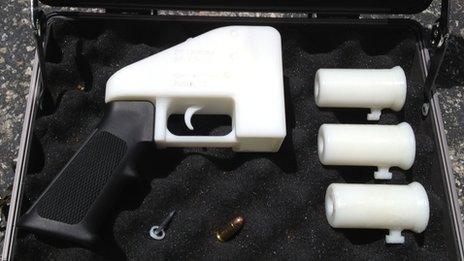Working gun made with 3D printer
- Published
- comments
The BBC's Rebecca Morelle saw the 3D-printed gun's first test in Austin, Texas
The world's first gun made with 3D printer technology has been successfully fired in the US.
The controversial group which created the firearm, Defense Distributed, plans to make the blueprints available online.
The group has spent a year trying to create the firearm, which was successfully tested on Saturday at a firing range south of Austin, Texas.
Anti-gun campaigners have criticised the project.
Europe's law enforcement agency said it was monitoring developments.
Victoria Baines, from Europol's cybercrime centre, said that at present criminals were more likely to pursue traditional routes to obtain firearms.
She added, however: "But as time goes on and as this technology becomes more user friendly and more cost effective, it is possible that some of these risks will emerge."
Defense Distributed is headed by Cody Wilson, a 25-year-old law student at the University of Texas.
Mr Wilson said: "I think a lot of people weren't expecting that this could be done."

The gun was assembled from separate printed components made from ABS plastic - only the firing pin was made from metal
3D printing has been hailed as the future of manufacturing.
The technology works by building up layer upon layer of material - typically plastic - to build complex solid objects.
The idea is that as the printers become cheaper, instead of buying goods from shops, consumers will instead be able to download designs and print out the items at home.
But as with all new technologies, there are risks as well as benefits.
Personal liberties
The gun was made on a 3D printer that cost $8,000 (£5,140) from the online auction site eBay.
It was assembled from separate printed components made from ABS plastic - only the firing pin was made from metal.
Mr Wilson, who describes himself as a crypto-anarchist, said his plans to make the design available were "about liberty".
He told the BBC: "There is a demand of guns - there just is. There are states all over the world that say you can't own firearms - and that's not true anymore.
"I'm seeing a world where technology says you can pretty much be able to have whatever you want. It's not up to the political players any more."
Asked if he felt any sense of responsibility about whose hands the gun might fall into, he told the BBC: "I recognise the tool might be used to harm other people - that's what the tool is - it's a gun.
"But I don't think that's a reason to not do it - or a reason not to put it out there."
Gun control
To make the gun, Mr Wilson received a manufacturing and seller's licence from the US Bureau of Alcohol, Tobacco, Firearms and Explosives (ATF).
Donna Sellers, from the ATF, told BBC News that the 3D-printed gun, as long as it was not a National Firearms Act weapon (an automatic gun, for example), was legal in the US.
She said: "[In the US] a person can manufacture a firearm for their own use. However, if they engage in the business of manufacture to sell a gun, they need a licence."
Amid America's ongoing gun debate in the wake of the shootings at Sandy Hook Elementary School in Newtown, Connecticut, US congressman Steve Israel recently called for a ban on 3D guns under the Undetectable Firearms Act.
Groups looking to tighten US gun laws have also expressed concern.
Leah Gunn Barrett, from New Yorkers Against Gun Violence, has said: "These guns could fall into the hands of people who should not have guns - criminals, people who are seriously mentally ill, people who are convicted of domestic violence, even children."
3D printing technology has already been used by some criminal organisations to create card readers - "skimmers" - that are inserted into bank machines.
Many law enforcement agencies around the world now have people dedicated to monitoring cybercrime and emerging technologies such as 3D printers.
Ms Baines from Europol said: "What we know is that technology proceeds much more quickly than we expect it to. So by getting one step ahead of the technological developments, we hope and believe we will be able to get one step ahead of the criminals as well."
- Published12 March 2013
- Published20 December 2012
- Published8 May 2013
- Published3 October 2012
- Published20 September 2012
- Published5 May 2013